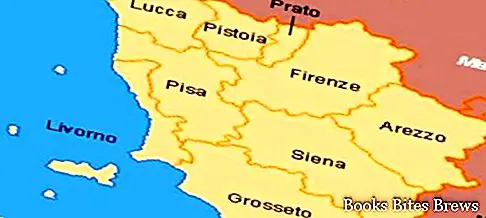What to see in Tuscany, itineraries including beautiful places to visit in this varied region, among hilly landscapes, plains, mountains, sea and cities of art.
Tourist information
Region of central Italy, with the northern offshoot reaching the dividing line beyond which northern Italy begins, Tuscany is extended on the western side of the Apennines and includes the islands of the Tuscan Archipelago including Elba Island, Isola del Giglio, Capraia Island, Montecristo Island and Pianosa Island.
Bathed by the Tyrrhenian Sea, it borders on Liguria, Emilia Romagna, Marche, Umbria and Lazio.
Its provinces are Florence, the regional capital, Arezzo, Grosseto, Livorno, Siena, Lucca, Massa Carrara, Pisa, Prato and Pistoia.
The Tuscan territory is largely hilly with some plains, relevant mountain ranges and the Apennines to the north and east.
The highest mountains are Monte Prado, Monte Giovo, Monte Rondinaio, Monte Pisanino, Alpe delle Tre Potenze, Pania della Croce, Monte Sumbra, Monte Tambura, Monte Amiata.
Other important mountain reliefs are the Apuan Alps, which divide the provinces of Lucca and Massa Carrara, the Pistoia mountains, the Chianti mountains, the Pratomagno, the Casentino and the metalliferous hills.
The major rivers are Arno, Ombrone and Serchio while the main lakes are Lake Chiusi, Lake San Casciano, Lake Montepulciano and Lake Massaciuccoli.
Bathed by the Tyrrhenian Sea, it offers a great tourist welcome even in summer for tourists who love the sea with its beautiful beaches including those of Versilia, San Vincenzo, Castiglion de La Pescaia, Punta Ala and Elba Island.
The most exclusive seaside resort is Forte dei Marmi while for mountain lovers the Garfagnana with its mountains and paths to go for interesting mountaineering excursions is to be taken into consideration.
Tuscany represents one of the best Italian regions to spend the holidays, being among those with the greatest historical, artistic and cultural heritage, as well as having a wide variety of landscape scenarios.
Recommended readings- Artimino (Tuscany): what to see
- San Galgano (Tuscany): what to see
- Poggibonsi (Tuscany): what to see
- Castiglione di Garfagnana (Tuscany): what to see
- Tuscany: Sunday day trips
What see
– Florence it is crossed by the Arno river and is considered the place of origin of the Renaissance with its numerous historic buildings, monuments and museums rich in art history including the Uffizi Gallery, the Palatine Gallery, the Bargello and the Palazzo Pitti museums.
– Arezzo is a charming town located at the confluence of three of the four valleys that make up its province; these valleys are the Casentino, the Upper Valdarno and the Val di Chiana.
– Grosseto is the main city of the Tuscan Maremma.
– Livorno, one of the most important Italian ports and headquarters of oil refineries, developed from the end of the sixteenth century by the will of the Medici. Famous people were born here including Amedeo Modigliani, Pietro Mascagni and Carlo Azeglio Ciampi.
– Lucca it is a city of art famous for having a sixteenth-century wall still intact and a historic center of significant artistic value. For the massive presence of buildings dedicated to Christian worship it is also known as a city of 100 churches. Piazza dell'Amfiteatro, Via Fillungo, Piazza San Michele and Piazza San Martino are just some of the places of tourist interest.
– Mass is the capital of the Province of Massa-Carrara.
– Carrara is a town in the Province of Massa-Carrara that enjoys international fame thanks to the renowned white marble extracted from the nearby Apuan Alps.
The city's monuments include the 12th century cathedral and the 16th century ducal palace which today houses the Academy of Fine Arts.
– Pisa It is famous above all for the leaning tower and the Piazza dei Miracoli where the Cathedral built in marble between 1063 and 1118, in Pisan Romanesque style, with the bronze portal of San Ranieri di Bonanno Pisano and the pulpit by Giovanni Pisano is located. Pisa is also home to the most important airport in Tuscany.
– Pistoia is a pretty town with the beautiful Cathedral of San Zeno which houses the silvery altar of San Jacopo inside.
– Meadow it is famous in Italy and worldwide for the textile industry. Crossed by the Bisenzio river it also has a beautiful historic center. The Cathedral is dedicated to Santo Stefano and is built in white and green marble, the interior has three naves and it houses the relic of the sacred belt, the frescoes by Filippo Lippi, Paolo Uccello and Agnolo Gaddi. Also outside there is a beautiful pulpit built by Michelozzo and decorated by Donatello. Palazzo Pretorio was the seat of the Podestà in the Middle Ages while today it is the Civic Museum. Palazzo Comunale has a neoclassical aspect and is the current seat of the Municipality.Castello dell'Imperatore was built by Emperor Frederick II with a square plan with eight towers but today only the external walls remain.
– Siena It is a city known above all for its remarkable artistic heritage, for its urban stylistic unity and for being immersed in an enviable hilly landscape.
- La Versilia is a renowned seaside area located in the north-western part of Tuscany which, extending from Torre del Lago in the south to the border with Marina di Massa in the north, includes Viareggio, Lido di Camaiore, Marina di Pietrasanta and Forte dei Marmi. Historical Versilia has a minor extension made up exclusively of Pietrasanta, Forte dei Marmi, Seravezza and Stazzema.
- La Countryside is a portion of the province of Lucca between the Apuan Alps and the Tuscan-Emilian Apennines. Bordering the Lunigiana, it is crossed by the Serchio river and is rich in woods. The main center is Castelnuovo di Garfagnana. Other important centers are Camporgiano, Castiglione, Gallicano, Minucciano, Piazza al Serchio, Pieve Fosciana, Villa Collemandina. Garfagnana offers a wide variety of natural and mountain landscapes.




